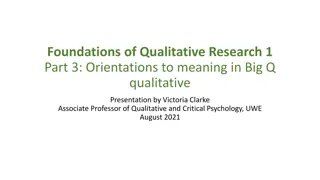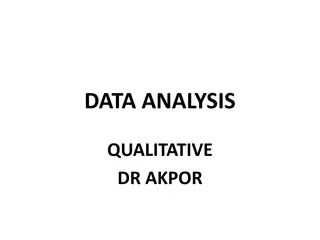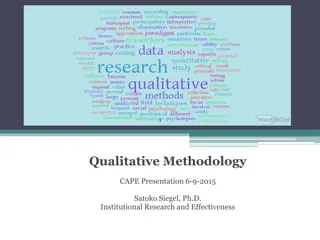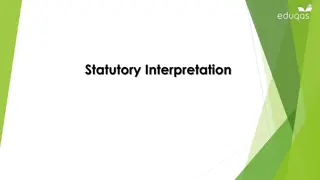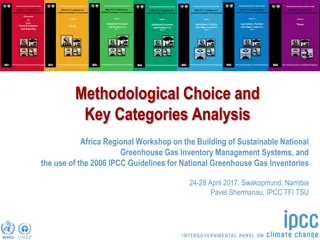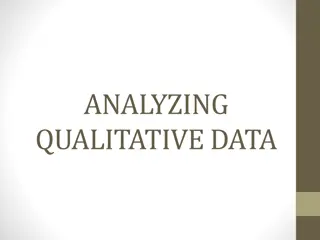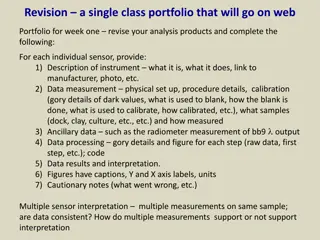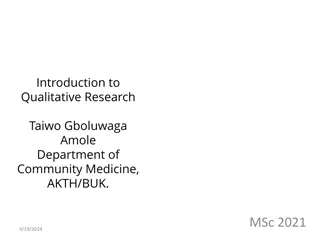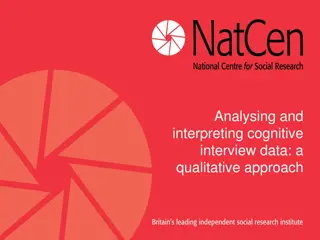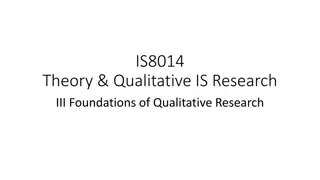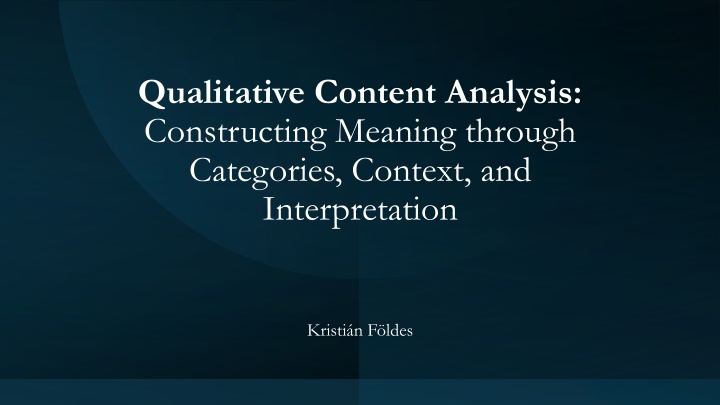
Qualitative Content Analysis: Constructing Meaning Through Interpretation
Dive into the world of Qualitative Content Analysis (QCA) where meaning is constructed through interpretation of categories and context. Explore the core ideas, key concepts, and examples of how texts go beyond written language. Unravel the nuances between fixed frameworks and interpretive freedom in analyzing textual and communicative data.
Download Presentation

Please find below an Image/Link to download the presentation.
The content on the website is provided AS IS for your information and personal use only. It may not be sold, licensed, or shared on other websites without obtaining consent from the author. If you encounter any issues during the download, it is possible that the publisher has removed the file from their server.
You are allowed to download the files provided on this website for personal or commercial use, subject to the condition that they are used lawfully. All files are the property of their respective owners.
The content on the website is provided AS IS for your information and personal use only. It may not be sold, licensed, or shared on other websites without obtaining consent from the author.
E N D
Presentation Transcript
Qualitative Content Analysis: Constructing Meaning through Categories, Context, and Interpretation Kristi n F ldes
My research interests Disinformation/Misinformation and Its Impact Propaganda: Methods and Consequences The Role of Social Media: Telegram, Facebook, Instagram International Migration: Trends and Challenges Constructing National Identity: Processes and Perspectives Differentiating Identities: Analyzing Self vs. Other
Opening Game: What Did They ReallySay?
What you just did is the core of QCA: interpret, categorize, and negotiate meaning.
Core Ideas: Meaning is constructed, not extracted Categories reflect theoretical and ideological positions Interpretation is subjective but can be structured and justified Highlights the tension between fixed frameworks and interpretive freedom Key Quote: Texts are not containers of meaning. They are sites of meaning-making. Theoretical Debrief
Key Concepts: A text is not limited to written or spoken language. In QCA, a text may be multimodal, including: Verbal: speeches, interviews, tweets Visual: images, political cartoons, memes Audiovisual: videos, advertisements, documentaries Digital/multimodal: social media posts combining text, emojis, hashtags, links, and visuals What Is a Text?
Examples: A tweet combining hashtags, sarcasm, and a meme A televised political debate with gesture, voice tone, and visuals A newspaper editorial layout with infographics What Is a Text?
Definition: QCA is a method for the systematic, rule-guided, and theory-informed analysis of textual and communicative data. It bridges interpretation and systematization, aiming to classify, compare, and interpret categories of meaning. What Is Qualitative Content Analysis?
What QCA is NOT: Not purely descriptive (like basic thematic analysis) Not quantitative content analysis, which counts without interpretation Not freeform hermeneutics it uses coding frames and systematic logic What Is Qualitative Content Analysis?
Ontology: Texts are discursive constructions, not mirrors of reality Discourse both reflects and shapes social realities Epistemology: QCA is interpretivist/constructivist Knowledge is situated, meaning is contextual and dependent on interpretive frameworks Ontology, Epistemology, and the Role of the Researcher
Hermeneutic Circle: Constant movement between parts and whole, foreground and background Example: interpreting a headline in isolation vs. within its article and political moment Researcher Reflexivity: Your theoretical lens and background shape coding QCA requires self-awareness of bias, ideology, and assumptions Ontology, Epistemology, and the Role of the Researcher
Definitions: Code: Conceptual label assigned to segment of text Category: Grouping of similar codes, often informed by theory Types of Codes: Manifest vs. Latent Descriptive vs. Analytical Semantic vs. Ideological Categories and Codes
Illustrative Example: "The media is lying again." Possible codes: Delegitimation of media, populist rhetoric, distrust of institutions, blame shifting Key Insight: "Coding is not labeling. It s abstraction guided by theoretical interest." Categories and Codes
Deductive: Theory-driven, top-down Categories are predefined, applied systematically Inductive: Data-driven, grounded Categories emerge through reading and pattern recognition Abductive: Iterative, reflexive Moves between theory and data to form the most plausible interpretation Deductive, Inductive, and Abductive Inference
Comparison Table Logic Source Goal Role of Theory Deductive Theory Apply High Inductive Data Discover Low Abductive Both Explain Medium
Coding Unit: Sentence, clause, paragraph, or thematic unit depending on research goals Context Unit: Surrounding discourse required to interpret meaning, influenced by genre and purpose Units of Analysis, Context, and Coding Frame
Coding Frame: Name: What you label the category. Definition: A clear conceptual description. Inclusion/Exclusion: What belongs in the category and what doesn't. Anchor Examples: Real quotes or text segments that exemplify how the category is applied. Memoing: Records reflections, analytical reasoning, and emergent insights Use for transparency and documenting epistemic decisions Units of Analysis, Context, and Coding Frame
Sampling in QCA: QCA requires purposeful, theoretically justified sampling Common strategies: Theoretical Sampling: Based on concepts and relevance to research question Maximum Variation: Capture the breadth of discourse Typical Case Sampling: Representative of the mainstream position Critical Case Sampling: Intense or exemplary cases Sampling, Reliability, Validity
Reliability in QCA: Reliability does not mean statistical replication, but transparency and consistency Strategies include: Well-defined coding frames Use of anchor examples and memoing Team coding with inter-coder dialogue Codebooks to guide application of categories Emphasize interpretive reliability over quantification Sampling, Reliability, Validity
Conceptual Validity: Do the categories used in the analysis truly reflect the theoretical concepts they are supposed to capture? This requires alignment between the coding frame and the research question. Interpretive Validity: Are the coding decisions coherent, well- supported by the text, and meaningful to others? Does the interpretation hold up under scrutiny? Sampling, Reliability, Validity
Strategies to Enhance Validity: Ensuring tight theoretical definitions for categories Including anchor examples that clarify ambiguous decisions Memoing to track interpretive choices and assumptions Peer debriefing or team coding discussions to expose bias Triangulation with additional data or analytical frameworks Sampling, Reliability, Validity
Decontextualization: Fragmenting meaning through segmentation risks losing nuance Power & Ideology: Often under-theorized unless paired with CDA or political discourse analysis Illusion of Objectivity: Categories may appear neutral but encode ideological assumptions Reflexive Solutions: Combine QCA with other frameworks (discourse, frame, narrative analysis) Use memoing and transparency to document interpretive moves Critiques and Limitations
1. Formulating Research Questions: Clearly define what you seek to understand. Example: How do media representations of climate change vary across different news outlets? 2. Locating Relevant Texts: Identify and collect texts that are relevant to your research question. Example: Collecting news articles from various outlets over a specific period. 3. Defining Sampling Units: Decide on the units of analysis (e.g., articles, paragraphs, sentences) and how they will be selected/coded for analysis. Example: Analyzing headlines and lead paragraphs from each article. Conducting the Analysis
4. Developing Coding Categories: Based on your research question, develop categories for coding your data. Example: Categories could include "Crisis Framing," "Scientific Evidence," "Political Discourse." 5. Selecting Analytical Procedures: Choose how you will analyze the coded data, such as thematic analysis or frequency analysis. Example: Conducting thematic analysis to identify dominant narratives in climate change reporting. 6. Ensuring Reliability and Validity: Implement strategies to check the reliability of your coding scheme and the validity of your findings. Example: Having multiple coders independently code a subset of the data and comparing results for consistency. Conducting the Analysis
"The government failed to act when the crisis first began. Now our families are paying the price for their incompetence. Foreign media are distorting the truth and fueling chaos. This is no longer just about politics it's about our survival. Real patriots must protect our homeland against these threats. They want to erase who we are and what we stand for. It s time to stand together and defend our national values." Example task for Assignement!
Text Segment Blame Fear Delegitimation Nationalism Us vs. Them The government failed to act when the crisis first began. 1 0 0 0 0 Now our families are paying the price for their incompetence. 1 0 0 0 0 Foreign media are distorting the truth and fueling chaos. 0 0 1 0 1 This is no longer just about politics it's about our survival. 0 1 0 0 0 Real patriots must protect our homeland against these threats. 0 1 0 1 1 They want to erase who we are and what we stand for. 0 1 0 1 1 It s time to stand together and defend our national values. 0 0 0 1 0
Thank you for your attention!



